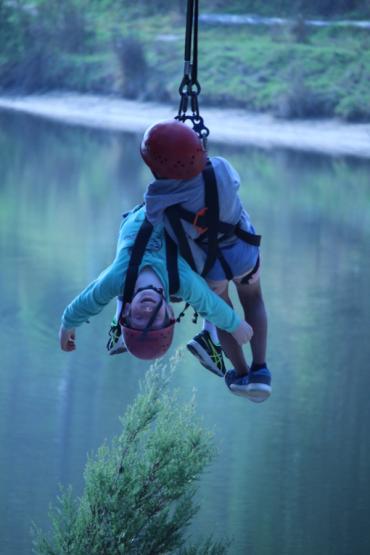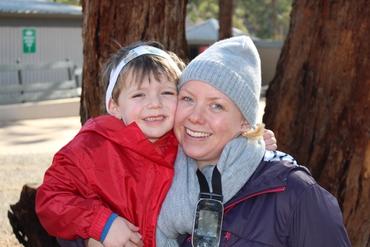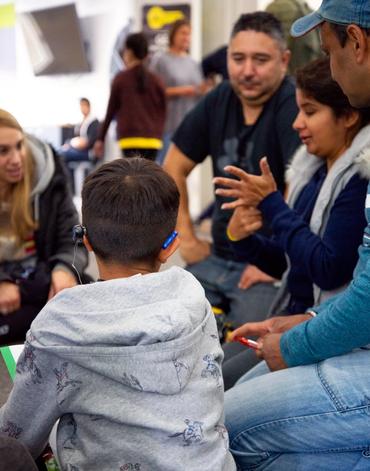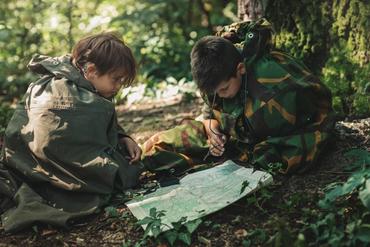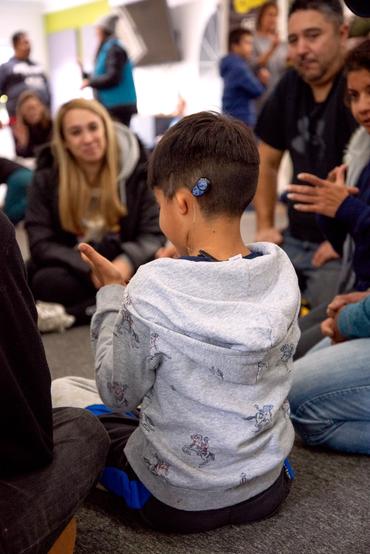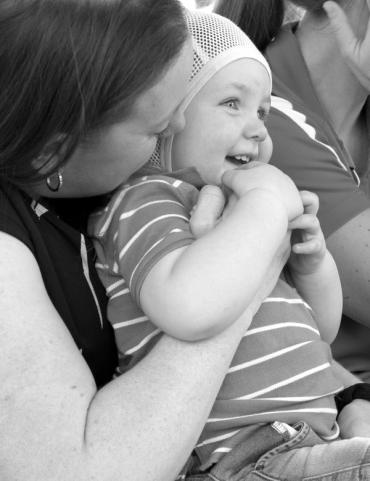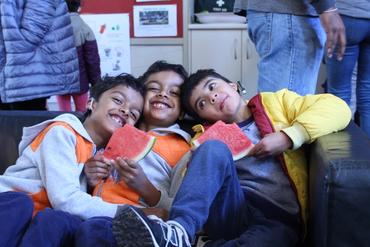Content Finder
There is a great deal of information available on the internet about deafness. We have collected a range of the key subjects parents told us were important to them - and you can check these out right here. Just use the drop-down filters to help focus on what interests you and we will feed in the relevant content.
The Importance of Rich Childhood Experiences.
When families and communities collaborate in positive ways, a deaf child's capacity to achieve their learning potential is significantly enhanced.
Family-Centered Practice in Early Intervention: A Comparison.
Early interventions programs should offer a wide range of services to cater to the diverse needs of families and encourage parents to be more involved.
The Effects of Vocabulary Intervention.
Building knowledge of word meanings is essential in developing reading comprehension skills. Both broad vocabulary knowledge – the number of words that are known – and depth of vocabulary knowledge – how well the words are known – are important.
Virtual- based learning: A new way of learning literacy?
In this study, research-based videos supplemented with research-based classroom activities and materials may help young deaf and hard of hearing children develop key literacy and language skills.
Universal Newborn Hearing Screening and Early Identification of Deafness.
Parents' responses to knowing early and their expectations of child communication development.
Assessing Social-Emotional Abilities of Infants.
Early intervention opportunities can help parents better understand their deaf or hard of hearing child's behaviour and teach parents how to promote their child's social and emotional development.
Education of the Deaf in Australia and Norway: A Comparative Study.
Greater use of sign language combined with social interaction strategies are could benefit deaf and hard of hearing students feel included.
Acquiring Auslan as a First Language.
At around four to seven months of age, in the same way hearing babies begin to babble vocally, babies acquiring sign language begin to babble on their hands.
Nurturing Language Development.
Children naturally engage with parents and caregivers in back-and-forth conversation, producing language interaction and joint attention, and this results in language development.
Children Who are Deaf and Hard of Hearing with an Autism Spectrum Disorder (ASD).
Assessment and intervention for ASD can require adapting or modifying the usual approaches to suit the needs of deaf and hard of hearing children.
Bilingual Bimodal approach to Language Acquisition.
Parents can help improve their child's language development by providing rich language experiences led by their child's language preferences.
Rethinking Literacy: Broadening opportunities for Visual Learners.
Literacy is not just reading, but includes the skills and knowledge needed for thinking, comprehending and communicating. Taking a broader approach to literacy opens the way for building on deaf and hard of hearing children’s strengths and potential as visual learners.
Parents using the Internet to Find Information.
Australian parents find the internet is a valuable addition to information provided by professionals.
Bilingual Programs: The Current State of Knowledge.
More research is needed, including studies reporting both reading and writing outcomes in sign bilingual programs.
Family- Centered Care and Early Intervention.
Making services more family- centered could help families enrol in early intervention more quickly.
Early Intervention Key to Improving Literacy Skills for Deaf Children.
There are great benefits for deaf children in having their parents read stories to them in sign language.
Language acquisition for deaf children: What linguists can do.
New evidence suggests that if children are exposed to a first language in the critical period of their first years, they may develop complete fluent use of any language.
A New discourse of Language Development in Deaf Children.
Children learning to communicate may benefit from using multiple modes of language- gestures, signs, spoken words and writing.
Enhancing Early Communication through Infant Sign Language.
With the right methods, it's possible to teach a baby as young as six months old to use a simple sign.
American Sign Language and Literacy: Exploring New Relationships.
Recent literature is suggesting that having a strong foundation in sign language will help in the development of English literacy skills.
Defending Deaf Culture: The Case of Cochlear Implants.
Deafness is recognised as a cultural identity rather than a disability.
Advantages of Early Visual Language.
It's a myth that sign language will hold back a deaf or hard of hearing child from developing spoken language. It has been shown that spoken language skills and English literacy actually increase as children learn more gestures and signs.
Children With Cochlear Implants: Changing Perspectives.
Deciding whether your child should receive cochlear implants is a challenging process for many parents. New research is changing perceptions about cochlear implants.
Beyond Early Intervention: Supports for School-Aged Children.
Improved intervention strategies for school-aged children with cochlear implants is needed to support learning.
Signing with Babies and Children: A summary of findings.
For infants and toddlers, signing can help develop language skills, expand vocabulary and improve reading skills.
Impact of Learning Environment on Children with a Cochlear Implant.
For children who have difficulty with interpreting and understanding speech, the listening environment could be improved to support their needs.
Best Practices in Family-Centered Early Intervention.
Family- Centered Early Intervention encourages active and enjoyable engagement to promote playful communicative interactions, family well-being and confidence in parenting and promoting your child's development.
Early signing in the home relates to literacy development.
Early language skills are important to developing literacy. Hearing parents as well as deaf parents can give their children early, consistent exposure to sign language to help them develop these skills.
- resource
- Research Insights
Training Literacy Skills through Sign Language
Literacy skills can improve using specialised literacy training programs utilising sign language.
- resource
- Research Insights
Deafness and Diversity: Early Intervention
Advancing technology has provided children who are deaf or hard of hearing with additional needs, greater access to sound and language than ever before.
Cochlear Implant Access in Six Developed Countries
Newborn hearing screening and the system of healthcare reimbursement contributes to Australia's high number of cochlear implant usage.
Australian Aboriginal Deaf People and Aboriginal Sign Language.
Supporting local signed languages in important for community communication.
Common Questions and Informed Evidence-based Answers.
Learning sign language together can be one of the strongest bonding experiences that the family and a deaf or hard of hearing child have.
The Impact of Childhood Hearing Loss on the Family..
Parenting a deaf or hard of hearing child can be challenging, but there are ways to cope and manage with this stress including family- centered support programs.
Principles and Guidelines for Early Intervention.
Once it has been confirmed that your baby or child is deaf or hard of hearing, early intervention is important.
Discovering Predictors to Successful Outcomes for Deaf or Hard of Hearing Children.
Early identification and intervention can lead to positive outcomes in age-appropriate language skills for deaf and hard of hearing children.
Support for parents of deaf children.
Common Questions and Informed, Evidence- Based Answers.
Interventions on parenting styles: a literature review.
Hearing parents can benefit from programs which boost their confidence in being able to raise a deaf or hard of hearing child.
Social Support for Parents of Deaf Children.
This research highlights the important role of social support for hearing parents of deaf and hard of hearing children.
The Importance of Family Supports and Resources for Parents.
Building a support crew can be really valuable when you find out your child is deaf or hard of hearing.
Prevalence of Additional Disabilities with Deafness: a review of the Literature.
The extent to which deafness may be associated with other disorders has received less attention and the few published estimates vary widely. This paper covers analysis done in the UK.
Listen Hear! The Economic Impact and Cost of Hearing Loss in Australia.
A study that looks at the economic impact, causes, prevalence, assessment, health and other social costs, impact on individual lives, educational requirements, medical and social care of deaf children and adults.
Parents with lived experience raising Deaf Plus children.
The acceptable term referring to deaf or hard of hearing children with additional needs is deaf plus.
Deafness and Attention in Deaf Children
Mothers play an integral role in the early years of their child's development.

